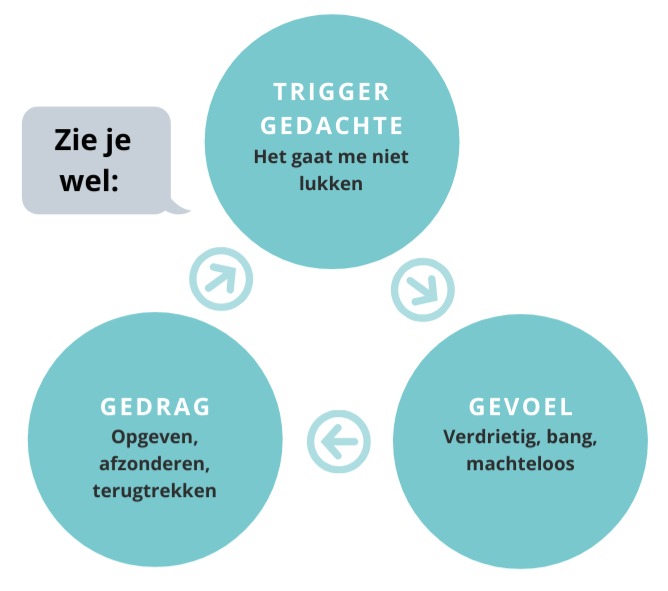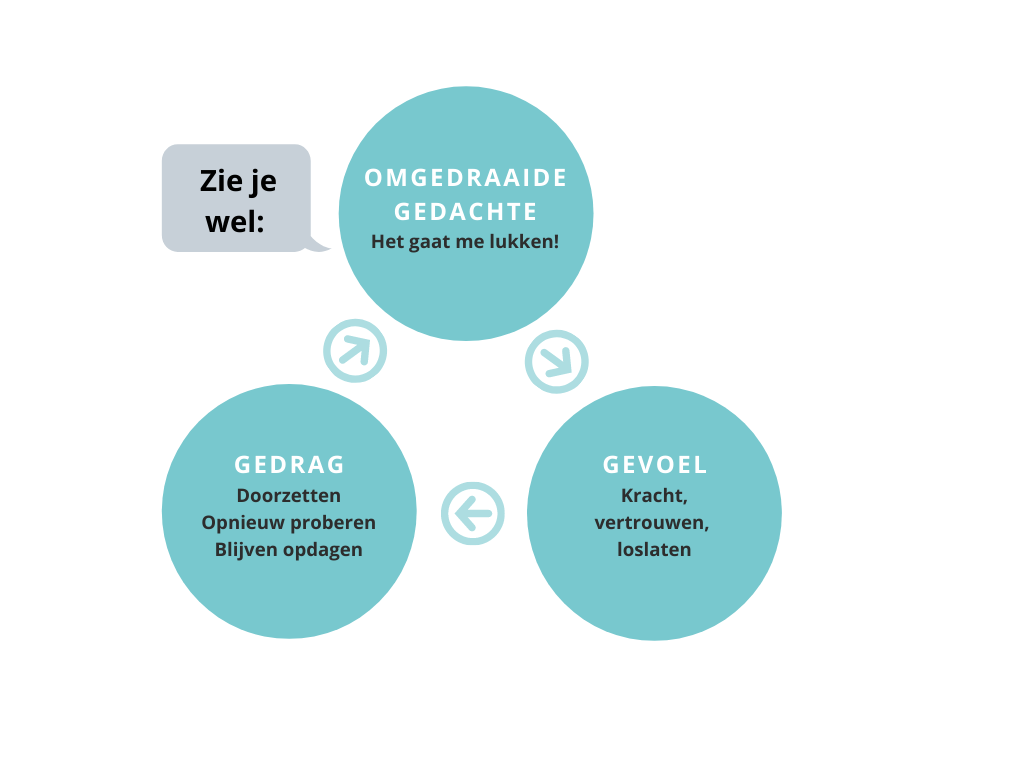Thoughts should be our best friends. Thoughts should encourage us, make us feel good, and give us confidence. Instead, they seem to be our worst enemies. Such as “I can’t” and “I can’t do that”, “I should do that” or “It’s all going wrong”. We so often have destructive thoughts, limiting thoughts, and it seems impossible to stop them.
I work with my clients to eliminate these limiting thoughts and install empowering thoughts in their place. Would you like to get started yourself to get your thoughts under control? Maybe this will help you further.
The law of control
No one in this world has any control over the world outside them.
For example: “your boss is rude” or “it’s raining on your wedding day”.
However, you do have control over what happens within yourself.
For example: “You let your boss’s tirade slide off you like water from a duck’s back” or “You dance with your wedding guests in the rain puddles.”
Your control begins and ends with your thinking. If you can control your thinking, you are always in control. If you can make your thoughts positive and empowering, you can make your life exactly the way you want it to be. Your thoughts control your feelings. Your feelings control your actions. Your actions control your experience. And you control what it all starts with: your thoughts. This way you have exactly the experience you want.
Once we understand how our mind and body work together, we can use the power of our thoughts to get where we want to be. Because everything that happens in your life starts with a thought. When things don’t work, it is because of a thought. And everything that does work is also the result of a thought. Our behavior – and therefore our experience – always expresses itself in a way that fits our thinking.
Looking for danger
Our brain is programmed to look for danger, to look for what could go wrong. From an evolutionary perspective, it is helpful for us to look for danger when things are unclear. When the consequences are the least predictable, quick (instinctive) action is needed the most. Therefore our attention is most often drawn to negative information, because that can greatly increase our chances of survival. The caveman who always assumed there was a lion behind the next rock was usually wrong, but he had a better chance of surviving (and reproducing) than someone who didn’t.
So, it’s easier to be negative than positive because it makes us more likely to survive. A present-day example is wearing a seat belt. That is “negative” because it means we expect to crash. But thanks to the seat belt, we have a better chance of surviving if there is a crash.
Take control of your experience
The good news is that we no longer need to be negative to survive. The world has changed, we are no longer exposed to wild tigers or threatened by poisonous berries in our smoothie fruit. And a global pandemic is not prevented or survived by being negative and preparing our bodies for fight, flight or freeze.
Today, we serve our bodies best by choosing to be positive and instructing our bodies with confidence. If we do, we will live happier, healthier and more productive lives. Even in times of unrest and uncertainty.
But how do we do that while our mind is automatically focused on the negative? The answer: through our thoughts. If we become aware of our thoughts and intentionally make them positive and supportive, our experience will be positive.
Looping thoughts
Here’s how it works: Our thoughts activate our feelings and our feelings determine our behavior. The behavior in turn forms evidence for the original thought and so we keep ourselves in a “thought loop”.

The thoughts you think trigger your feelings and behavior: your thoughts are like instructions to your body. Everything you feel starts with a thought. Think about that for a moment. If you’re feeling a little sad, there has been a thought that caused it. This is the “trigger thought”.
The same goes for when we’re angry. We may think that someone else made us angry, but there is always a thought between what the other person said or did and your feeling. This thought is the trigger for how you feel. And this feeling, in turn, is the trigger for your reaction, action or behavior. We often don’t remember what the “trigger thought” was, but it is always there. If we become aware of this thought, we can change our lives.
An example
Let’s take an example. I was at the drug store recently, a small friendly neighborhood store close to my house. A woman was standing in front of me at the cash register. I kept an appropriate distance. When she said goodbye, I walked forward, but I hadn’t noticed that she was still packing her things away. I had gotten too close to her because of that. She bit an unkind remark at me. I was startled and momentarily upset at being reprimanded so unkindly. I felt like I was 6 years old again and was scolded by my mother. I became aware of the thought that caused this feeling. It was something like: “I’m a bad (or in this corona time: irresponsible) person, I’m stupid”. Self-rejection.
If I hadn’t noticed that I was causing my own pain by rejecting myself with these thoughts, I most likely would have gone to the next emotional level: self-defense for feeling attacked. I may have snapped back an unkind comment.
So instead of going into a negative thought loop (see picture), I took control of my thoughts and turned them around by saying to myself, “It’s okay, I’m not stupid, I’m smart, I wasn’t paying attention, it can happen”. And immediately my body relaxed, I smiled and apologized and the woman calmly walked away. A sigh of relief went through the store, as the owner and other visitor had also felt the tension in the air.
A small example, but it shows how we can talk to our mind to get the feelings we desire (in my case: calm, kind and gentle). And because these feelings influence our behavior, it also positively affects the people around us.
The power is in you
In short: when you feel a negative emotion, for example fear or stress, you need to become aware of the ‘trigger thought’ (e.g. I am in danger, I will get sick, there will be lack) and convert it into a positive, supportive one. thought (e.g. I am safe, I am healthy, there is abundance).

Your subconscious doesn’t know and doesn’t care if what you’re saying is true or false, good or bad, helpful or unhelpful. It just lets it in. We are all constantly talking to ourselves and filling our minds with words and pictures. Now that we know that we have full control over choosing these words and images ourselves, we can improve our experience every day.
So, fill yourself with powerful, positive and descriptive words. Your body will respond by giving you the feeling that fits these words and pictures. Your body and mind are doing their job, so you do yours too and always give yourself the very best instructions. You deserve it!


